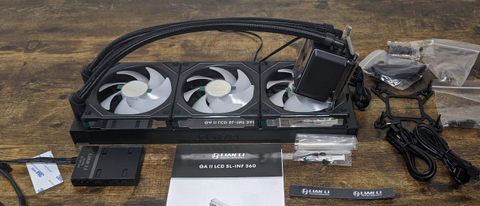Tom's Hardware Verdict
Lian Li’s Galahad II LCD 360 provides the cooling strength you’ll need to keep your i9-14900K under control. It’s arguably overkill for any lesser CPU, but if you need to keep Intel’s flagship performing its best under heavy workloads, it’s a lot cheaper and easier to install than a custom cooling loop.
Pros
- +
One of the strongest AIOs on the market
- +
2.88-inch IPS Screen
- +
Tons of customization options
Cons
- -
High price
Why you can trust Tom's Hardware
Today’s review will cover Lian Li’s latest AIO cooler, the Galahad II 360 LCD. We’ve recently tested the company’s GA II 280 LCD and the non-LCD GA II 360 and found both to perform among the best AIOs on the market. Given this latest cooler’s similarity to those previous models, I already know that this cooler is going to perform well on the i7-13700K testing rig we usually use for cooler testing. So I wanted to do things a bit differently this time around and explore how the Galahad II 360 LCD handles the hottest CPU on the market, Intel’s Core i9-14900K.
I’ll investigate how Intel’s i9-14900K performs with coolers of all classes – SFF cooling, air cooling, and liquid cooling – to see just what sort of temperatures and power consumption you can expect with Intel’s i9-14900K. We’ll also briefly cover undervolting.
But first, let’s take a look at the features of Lian Li’s Galahad II 360 LCD before diving into the benchmarks.

Cooler specifications
| Cooler | Lian Li Galahad II LCD 360mm |
| MSRP | $249.99 USD (normal version) $289.99 USD (SL Infinity version) |
| Heatsink Material | Aluminum, Single Wave Fins |
| Socket Compatibility | Intel Socket LGA 115x/1200/1700 AMD AM5 / AM4 |
| Base | Nickel-Plated Copper |
| Max TDP (Our Testing) | ~330W with Intel’s i9-14900K |
| Installed Size (with fans) | 399.5mm (L) x 120 mm (W) x 55mm (D) |
| Warranty | 6 years |
Packing and included contents

Included in the box with the cooler are the following:
- 360mm AIO
- Three 120mm fans
- Mounting for modern AMD and Intel Platforms
- Pre-applied Thermal Paste
- Cable management ties
- PWM splitter cable
- Fan Hub (SL-INF version only)
Lian Li sells two versions of the GA II LCD 360, the SL-INF model pictured here for $289, which includes the fancier SL-INF fans with side infinity mirror illumination and a more standard version, without the fan hub/control box, which is available for $249 USD. Other than the lack of infinity mirrors on the standard version, there are a few differences between the fans. The SL-INF version’s fans are rated at 29 dBA, 1 dBA less than the standard version. However, the standard version’s fans have higher static pressure ratings with 3.26mmH20 vs 2.66 on the SL-INF version along with higher amounts of airflow with a rating of 79.9 CFM vs 61.3 CFM.
Given that, otherwise, the radiator and pump used in both units were the same, this might mean that the standard version would have a slight edge in the most intensive workloads - but for most users, performance differences between these units will be minimal.
I had originally tested the SL-INF version, but I ran into a few issues with the unit that Lian Li sent. The company then sent the standard model as replacement, which I’ve tested with Intel’s i9-14900K, along with a few other coolers to get a sense of what it takes to cool Intel’s flagship CPU.
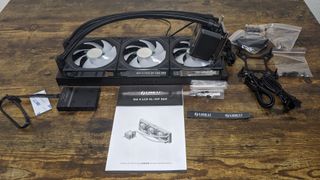
Features of Lian Li’s Galahad II LCD 360mm AIO
LCD Display CPU Block
The most eye-catching feature of this AIO is, as its name implies, the vibrant LCD display panel on the top of the CPU block. It’s a square 2.88-inch (480 x 480-pixel) IPS screen.

L-Connect 3 Software Suite
To utilize the IPS display, you’ll need to download the latest version of Lian Li’s L-Connect software, which also offers (optional) integration to control fan and pump speeds as well as ARGB lighting settings.
You’ll find a wide variety of customization options for the LCD display offered within the software. You can choose from a variety of effects, and even upload a video up to 3 minutes long.

8th generation Asetek liquid pump
The Galahad II LCD features the latest (8th generation) Asetek water pump, which the company claims delivers up to a 2°C/100W improvement compared to its previous generation design.
- Upgraded pump utilizes a three-phase motor for higher liquid flow and quieter operation
- Optimized design increases overall surface area and decreases flow impedance
- Under-the-hood enhancements for quieter operation versus previous generations
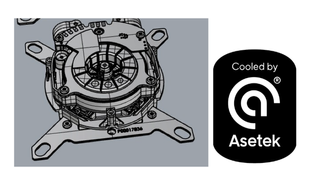
Full RAM compatibility
Like most other AIOs on the market, the Galahad II LCD is compatible with any height of DDR4 or DDR5 RAM modules, as it doesn’t interfere or overhang DIMM modules.
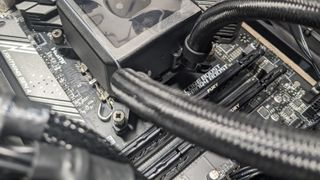
Fan Control Hub (SL-INF version only)
The SL-INF version of this cooler includes a hardware hub allowing control and syncronized lighting of additional fans, if you prefer.

Large Copper Contact Plate, Rotatable Tubing
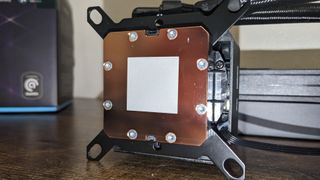
This AIO has a copper CPU contact plate with a design that’s been optimized for the latest Intel and AMD CPUs. The tubing that connects to the CPU block and radiator is rotatable, allowing for easier installation.

LGA1700 Socket Bending
There are many factors other than the CPU cooler that can influence your cooling performance, including the case you use and the fans installed in it. A system's motherboard can also influence this, especially if it suffers from bending, which results in poor cooler contact with the CPU.
To prevent bending from impacting our cooling results, we’ve installed Thermalright’s LGA 1700 contact frame into our testing rig. If your motherboard is affected by bending, your thermal results will be worse than those shown below. Not all motherboards are affected equally by this issue. I tested Raptor Lake CPUs in two motherboards. And while one of them showed significant thermal improvements after installing Thermalright’s LGA1700 contact frame, the other motherboard showed no difference in temperatures whatsoever! Check out our review of the contact frame for more information.
Testing methodology
Today's highest-end CPUs, whether Intel or AMD, are difficult to cool in intensive workloads. In the past. reaching 95 degrees Celsius or more on a desktop CPU might have been a cause for concern. But with today’s top-end CPUs, this is considered normal operation. Similar behavior has been present in laptops for years due to cooling limitations in tight spaces.
All testing is performed with a 23 degrees C ambient room temperature. Multiple thermal tests are run on each CPU to test the cooler in a variety of conditions, and acoustic measurements are taken with each result.
This article is intended to provide a brief overview of cooling Intel’s i9-14900K and how different classes of coolers perform. This article won’t cover noise levels, if you’re interested in the noise levels of different coolers please refer to our latest review of Corsair’s A115 air cooler or Silverstone’s IceMyst AIOs.
Todays tests include:
1. Brief undervolting tests
2. “Out of the box” / Default configuration thermal testing with no power limits enforced
3. Thermal results in power-limited scenarios
a.) Power limited to 200W to emulate a medium intensity workload
b.) Power limited to 125W to emulate a low intensity workload
The thermal results included are for 10-minute testing runs. To be sure that was sufficiently long to tax the cooler, we tested both Thermalright’s Assassin X 120 R SE and DeepCool’s LT720 with a 30-minute Cinebench test with Intel’s i9-13900K for both 10 minutes and 30 minutes. The results didn’t change much at all with the longer test: The average clock speeds maintained dropped by 29 MHz on DeepCool’s LT720 and 31 MHz on Thermalright’s Assassin X 120 R SE. That’s an incredibly small 0.6% difference in clock speeds maintained, a margin of error difference that tells us that the 10-minute tests are indeed long enough to properly test the coolers.
Testing configuration – Intel LGA1700 platform
| CPU | Intel Core i9-14900K | Row 0 - Cell 2 |
| Case | Be Quiet! Dark Base Pro 901 | Row 1 - Cell 2 |
| Monitor | LG 45GR95QE | Row 2 - Cell 2 |

Albert Thomas is a contributor for Tom’s Hardware, primarily covering CPU cooling reviews.
-
RitiFamily Albert... Recently, I read the article on AIO tube placement and to avoid putting the in and out tubes at the top. WHY then would you do exactly what you recommended NOT to do? Tubes look long enough to place at bottom??! and this isn't just to be confrontational, it truly is for my knowledge . I'm about to start a system build for myself and I've never used AIO before. Thanks bud..Reply -
helper800 Thanks for the review as always Albert. I was wondering why a larger chart with the other AIO's you have tested in the past compared to this Lian Li AIO was not included like you did with the noise levels? Ohh, and of course, the arbitrary reminder of testing the Arctic AIO products. ;)Reply -
UnforcedERROR Reply
It's about longevity and noise more than anything. You always want the radiator mounted higher than the pump, that way air can't get trapped in the pump. If you orient your tubes at the bottom the air will sit at the top of the radiator and have no way to get into the pump. If the tubes are at the top you could potentially have air trapped in the pump since there's less space for it to settle, but it is more likely over time rather than an immediate issue. Air in the pump causes noise and can cause it to weaken the pump, but it's a gradual problem. All AIOs have some air in them, and you'll hear the pump pushing it out on initial install, but it'll float to the highest point it can reach (presumably the top of the radiator).RitiFamily said:Albert... Recently, I read the article on AIO tube placement and to avoid putting the in and out tubes at the top. WHY then would you do exactly what you recommended NOT to do? Tubes look long enough to place at bottom??! and this isn't just to be confrontational, it truly is for my knowledge . I'm about to start a system build for myself and I've never used AIO before. Thanks bud..
When it comes to testing it's not much of a factor since no one is going to review the unit over a 2-3 year lifespan. -
Albert.Thomas Reply
I take the 5th with a side comment that it shouldn't impact basic testing resultsRitiFamily said:Albert... Recently, I read the article on AIO tube placement and to avoid putting the in and out tubes at the top. WHY then would you do exactly what you recommended NOT to do? Tubes look long enough to place at bottom??! and this isn't just to be confrontational, it truly is for my knowledge . I'm about to start a system build for myself and I've never used AIO before. Thanks bud.. -
Albert.Thomas Reply
1753111559809957931View: https://twitter.com/ultrawide219/status/1753111559809957931helper800 said:Thanks for the review as always Albert. I was wondering why a larger chart with the other AIO's you have tested in the past compared to this Lian Li AIO was not included like you did with the noise levels? Ohh, and of course, the arbitrary reminder of testing the Arctic AIO products. ;) -
helper800 Reply
LOL.Albert.Thomas said:I take the 5th with a side comment that it shouldn't impact basic testing results
Ohhhh, thats what you meant last time you said that! I am not a person who goes on X/Twitter so I never saw it. I honestly thought you were kinda just, cough leaking cough, a future product in no certain terms. Thats great to hear that a III is coming at some point. I look forward to your future review, I'll get off your back now. :ROFLMAO:Albert.Thomas said:1753111559809957931View: https://twitter.com/ultrawide219/status/1753111559809957931 -
Tom Sunday The last time I kneeled under my desk and checking the inside of my PC was about 8-months ago! WOW…Lian Li is now offering me for a cool $310 (including sales tax) in confirming and blinking the time of the day! In all of my15-plus years being a DIY PC enthusiast, nobody ever came over to my house wanting to inspecting the insides of my system. The precious few guests were basically just looking at the keyboard and my monitor. Just perhaps whenever I get finally ready in buying a new car…they will offer me a "see-through hood" so that all my friends can ogle my motor and with RGB lighting being a small extra.Reply -
thestryker I find it very interesting that Lian-li used two types of pumps for the Galahad II. I wouldn't get this one as I purposely avoid Asetek due to their patent abuse, but it's good that this design isn't much worse than the performance version with their in house design.Reply
This just looks like an excuse to test the LFII vs LFIII to me! I'm pretty excited about this release as the LFII has been so good, and it looks like the top of the pump housing has a fan which should be a pretty good upgrade over the tiny one.Albert.Thomas said:1753111559809957931View: https://twitter.com/ultrawide219/status/1753111559809957931 -
TerryLaze Who came up with the testing method?!Reply
Why unlimited power and then 200W?
Why is no test being made on the actual power limit of 253W that intel tells us to use, and that most people will stick to if they won't use unlimited power(overclocking) ?
